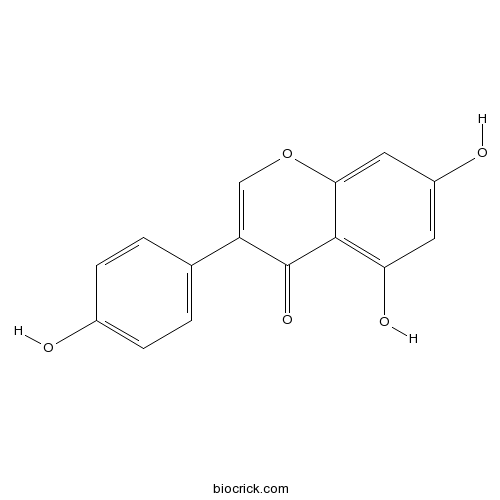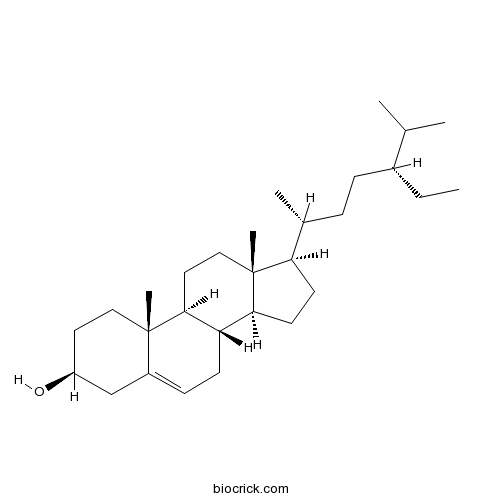Flemingia macrophylla
Flemingia macrophylla
1. The products in our compound library are selected from thousands of unique natural products; 2. It has the characteristics of diverse structure, diverse sources and wide coverage of activities; 3. Provide information on the activity of products from major journals, patents and research reports around the world, providing theoretical direction and research basis for further research and screening; 4. Free combination according to the type, source, target and disease of natural product; 5. The compound powder is placed in a covered tube and then discharged into a 10 x 10 cryostat; 6. Transport in ice pack or dry ice pack. Please store it at -20 °C as soon as possible after receiving the product, and use it as soon as possible after opening.
Natural products/compounds from Flemingia macrophylla
- Cat.No. Product Name CAS Number COA
-
BCN5499
Genistein446-72-0
Instructions

-
BCN1015
Beta-Sitosterol83-46-5
Instructions

Polysubstituted Isoflavonoids from Spatholobus suberectus, Flemingia macrophylla, and Cudrania cochinchinensis.[Pubmed: 28110438]
Four hitherto unknown polysubstituted isoflavonoids, including three isoflavans: 7,4'-dihydroxy-8,2',3'-trimethoxyisoflavan (1), 7,2',4'-trihydroxy-8,3'-dimethoxyisoflavan (2), and 7,2',4'-trihydroxy-5-methoxyisoflavan (3), and one prenylated isoflavone cudraisoflavone M (4) were isolated from the ethanol extracts of Spatholobus suberectus (for 1 and 2), Flemingia macrophylla (for 3), and Cudrania cochinchinensis (for 4), respectively. Their structures were established on the basis of extensive spectroscopic analysis. Compounds 1 and 4 exhibited weak cytotoxic activity against five human cancer cell lines (HL-60, A-549, SMMC-7721, MCF-7, and SW-480).
Changes in in vitro ruminal and post-ruminal degradation of tropical tannin-rich legumes due to varying levels of polyethylene glycol.[Pubmed: 28052457]
We evaluated the effects of tannins from Flemingia macrophylla (CIAT 17403) and Calliandra calothyrsus (San Ramón CIAT 22310 and Patulul CIAT 22316) on in vitro ruminal and post-ruminal dry matter and apparent protein degradation. For each tannin source (legumes), different dosages of polyethylene glycol (PEG) (8000 Da) in McDougall buffer were added to achieve ratios of 0:3, 1:3, 2:3 and 3:3 PEG:condensed tannin (CT). Ruminal fluid mixed with McDougall buffer (1:4) was added to tubes containing only legume foliage (control) or PEG-treated legume foliage. For both Calliandra varieties, a higher ruminal dry matter degradation was observed at a PEG:CT ratio of 3:3. For F. macrophylla, no differences were found between 2:3 and 3:3 ratios (p > 0.05), indicating that a PEG:CT ratio of 2:3 might be enough to bind tannins. Increasing PEG:CT ratios increased apparent ruminal degraded protein and ammonia concentration (p < 0.0001) differing among species (species × ratio: p < 0.0001). The degradation of bypass crude protein (dBCP) was influenced by both legume type and PEG:CT ratio (p < 0.0001). For Patulul, as PEG:CT ratio increased, dBCP increased, but after tannin ratio of 2:3, there was not a significant increase, and for San Ramón, dBCP degradation was higher as PEG:CT ratio increased up to 2:3. For Flemingia, dBCP was higher than PEG:CT ratio of 0:3 but not different among 1:3, 2:3 or 3:3. Low concentration of CT (116 mg/g DM) increased the proportion of protein digested in the abomasum, but higher levels of CT (252 mg/g) clearly reduced the proportion of digested CP. For Flemingia, PEG:CT ratio of 2:3 is enough to inactivate tannins, while PEG:CT ratio of 3:3 was needed for Calliandra and consequently increased ruminal degradation of dry mater (rdDM), and crude protein (rdCP), total degradation of dry matter (tdDM), crude protein (tdCP) and ammonia levels.
Supplementation of Flemingia macrophylla and cassava foliage as a rumen enhancer on fermentation efficiency and estimated methane production in dairy steers.[Pubmed: 27473104]
Four rumen-fistulated dairy steers, 3 years old with 180 ± 15 kg body weight (BW), were randomly assigned according to a 4 × 4 Latin square design to investigate on the effect of Flemingia macrophylla hay meal (FMH) and cassava hay meal (CH) supplementation on rumen fermentation efficiency and estimated methane production. The treatments were as follows: T1 = non-supplement, T2 = CH supplementation at 150 g/head/day, T3 = FMH supplementation at 150 g/head/day, and T4 = CH + FMH supplementation at 75 and 75 g/head/day. All steers were fed rice straw ad libitum and concentrate was offered at 0.5 % of BW. Results revealed that supplementation of CH and/or FMH did not affect on feed intake (P > 0.05) while digestibility of crude protein and neutral detergent fiber were increased especially in steers receiving FMH and CH+FMH (P < 0.05). Ruminal pH, temperature, and blood urea nitrogen were similar among treatments while ammonia nitrogen was increased in all supplemented groups (P < 0.05). Furthermore, propionic acid (C3) was increased while acetic acid (C2), C2:C3 ratio, and estimated methane production were decreased by dietary treatments. Protozoa and fungi population were not affected by dietary supplement while viable bacteria count increased in steers receiving FMH. Supplementation of FMH and/or FMH+CH increased microbial crude protein and efficiency of microbial nitrogen supply. This study concluded FMH (150 g/head/day) and/or CH+FMH (75 and 75 g/head/day) supplementation could be used as a rumen enhancer for increasing nutrient digestibility, rumen fermentation efficiency, and microbial protein synthesis while decreasing estimated methane production without adverse effect on voluntary feed intake of dairy steers fed rice straw.
[Optimal extraction technology for genistein in Flemingia macrophylla with response surface method].[Pubmed: 24761681]
To optimize extraction techniques for genistein in Flemingia macrophylla by using response surface method.
Isoflavonoid-Rich Flemingia macrophylla Extract Attenuates UVB-Induced Skin Damage by Scavenging Reactive Oxygen Species and Inhibiting MAP Kinase and MMP Expression.[Pubmed: 23935672]
In this study, we investigated the antioxidant activity and anti-photoaging properties of an extract of Flemingia macrophylla, a plant rich in isoflavonoid content. Pretreatment of fibroblasts with Flemingia macrophylla extract (FME) inhibited elastase activity, promoted the protein expression of type I procollagen, and attenuated the phosphorylation of mitogen-activated protein (MAP) kinase and the protein expression of matrix-metalloproteinase- (MMP-) 1, 3, and 9. The IC50 values were 2.1 μ g/mL for DPPH radical scavenging ability, 366.8 μ g/mL for superoxide anion scavenging ability, 178.9 μ g/mL for hydrogen peroxide scavenging ability, and 230.9 μ g/mL for hydroxyl radical scavenging ability. Also, exposure of erythrocytes to various concentrations of FME (50-500 μ g/mL) resulted in a dose- and time-dependent inhibition of AAPH-induced hemolysis. In human fibroblasts, FME at 10 μ g/mL was shown to be a potent scavenger of UV-induced reactive oxygen species (ROS). The antioxidant and anti-photoaging properties of FME make it an ideal anti-intrinsic aging and anti-photoaging agent.
Phyto-SERM constitutes from Flemingia macrophylla.[Pubmed: 23896592]
The methanolic extract of Flemingia macrophylla roots exhibited significant estrogenic activity in the transgenic plant assay system which was comparable to the activity of soybean extract. Utilizing estrogenic activity-guided fractionation, one new compound, fleminigin, together with 23 known compounds were isolated from F. macrophylla roots' methanolic extract. The structure of the new compound was identified based on intensive spectroscopic analysis and the full spectral data for one of the isolated compounds, flemichin E, was introduced for the first time in the current investigation. The estrogenic and anti-estrogenic activities of the isolated compounds were evaluated revealing that the isolated isoflavonoids may act as partial estrogen agonists, as well as antagonists. Additionally, the anti-inflammatory and the cytotoxic activities of the isolated compounds were studied. These results suggested the potential applications of F. macrophylla extract and its isolated compounds as selective estrogen receptor modulators (SERMs).
Antioxidant and Antityrosinase Activity of Flemingia macrophylla and Glycine tomentella Roots.[Pubmed: 22997529]
The antioxidant and antityrosinase activities of the water extract of Flemingia macrophylla root (WEFM) were investigated. The results showed that WEFM exhibited radical scavenging and reducing activities, as well as ferrous ion chelating property. In addition, WEFM also protected phospholipids against oxidation, indicating that WEFM could protect biomolecules from oxidative damage. Meanwhile, in the range of 50-100 μg/mL, the tyrosinase inhibitory activity of WEFM increased with an increase in sample concentration and was superior to that of the water extract of Glycine tomentella root (WEGT). A high performance liquid chromatography analysis was used to determine the phenolic components, revealing that daidzin, daidzein, genistin, and genistein were present in WEFM and WEGT. Acting as an antioxidant and a tyrosinase inhibitor, these bioactive constituents could contribute to the protective effects of WEFM. Overall, the results showed that WEFM might serve as a natural antioxidant and tyrosinase inhibitor.
The Components of Flemingia macrophylla Attenuate Amyloid β-Protein Accumulation by Regulating Amyloid β-Protein Metabolic Pathway.[Pubmed: 22719789]
Flemingia macrophylla (Leguminosae) is a popular traditional remedy used in Taiwan as anti-inflammatory, promoting blood circulation and antidiabetes agent. Recent study also suggested its neuroprotective activity against Alzheimer's disease. Therefore, the effects of F. macrophylla on Aβ production and degradation were studied. The effect of F. macrophylla on Aβ metabolism was detected using the cultured mouse neuroblastoma cells N2a transfected with human Swedish mutant APP (swAPP-N2a cells). The effects on Aβ degradation were evaluated on a cell-free system. An ELISA assay was applied to detect the level of Aβ1-40 and Aβ1-42. Western blots assay was employed to measure the levels of soluble amyloid precursor protein and insulin degrading enzyme (IDE). Three fractions of F. macrophylla modified Aβ accumulation by both inhibiting β-secretase and activating IDE. Three flavonoids modified Aβ accumulation by activating IDE. The activated IDE pool by the flavonoids was distinctly regulated by bacitracin (an IDE inhibitor). Furthermore, flavonoid 94-18-13 also modulates Aβ accumulation by enhancing IDE expression. In conclusion, the components of F. macrophylla possess the potential for developing new therapeutic drugs for Alzheimer's disease.
Hepatoprotective effect of the aqueous extract of Flemingia macrophylla on carbon tetrachloride-induced acute hepatotoxicity in rats through anti-oxidative activities.[Pubmed: 21476211]
This study investigated the protective effect of the aqueous extract of Flemingia macrophylla (AFM) against hepatic injury induced by CCl(4). Alanine aminotransferase (ALT) and aspartate aminotransferase (AST) were detected as biomarkers in the blood to indicate hepatic injury. Product of lipid peroxidation (MDA), superoxide dismutase (SOD), catalase (CAT), glutathione peroxidase (GSH-Px), and reduced glutathione (GSH) contents were evaluated for oxidative stress in hepatic injury. Moreover, histopathological observation was assayed for the degree of hepatic injury. After oral administration of AFM, 0.5 g/kg and 1.0 g/kg doses significantly decreased ALT and AST, attenuated the histopathology of hepatic injury, ameliorated oxidative stress in hepatic tissue, and increased the activities of CAT, SOD and GSH-Px. The hepatoprotective effect of daidzein and genistein were consistent to that of AFM. This study demonstrated for the first time that AFM has hepatoprotective effect on acute liver injuries induced by CCl(4), and the results suggested that the effect of AFM against CCl(4)-induced liver damage was related to antioxidant properties.


